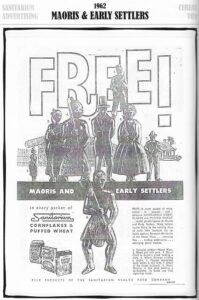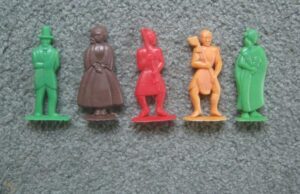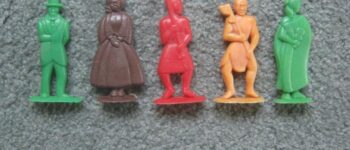1962: Maoris and Early Settlers
May 12, 2022
By AHNZ

In April, 1962, the Sanitarium Health and Wellbeing Company released a very historically interesting set of toys in every packet of cornflakes and puffed wheat. The Maoris and Early Settlers series consisted of 8 figures advertised (image, left) as follows:
- Colonial soldier- Maoris wars
- Maori girl with pois
- Maori Chief in dogskin cloak holding a mere
- Maori Warrior holding a tiaha
- Typical top-hatted early settler
- His wife
- Miner of the Otago goldrush
- Maori Warrior in flax skirt holding a tewhatewha (a battle axe with signalling vane)
After writing the post Free Gift Inside and Intelligent Cereal Boxes I managed to borrow Stephen Summers and Peter Fisher’s 2006 book New Zealand Cereal Toys 1950-2000. A very handy book to help catalogue some of the known breakfast box toys. One thing that made my jaw drop was their observation that many of the toys survived their first wave of use because grandparents held onto them for the next generation to come. That’s a deduction I had made independently myself by reaching back into old glimmerings of memory.
“Like most toys, the attrition rate was high, however a few eventually ended up in shoeboxes or ice cream containers and were stored away and largely forgotten about until grandchildren came visiting and they were bought out for a second tour of duty.” – Summers and Fisher (2006)
“It turns out that the little Weetbix boomerang along with the little plastic molded Maori, crocodile, farm animals, upright gorillas, battleships etc. belonged to the era of older cousins I was too young to really know but old aunts and grandparents had kept them for the 80s kids who knew nothing of their prior intrinsic value.” – 1950s: Free Gift Inside, AHNZ
Until the Government ruined it (the government ruins everything,) the Sanitarium and Kellogg issue toys were regular and of growing quality and creativity according to the authors. I presume it was Labour 4.0 who ruined this for children after they established the Ministry of Consumer Affairs in 1986. New Zealand’s first such Minister, David Butcher, was probably putting on a show of being the champion of some concerned womens’ Fun Police in order to try to save his government from losing the 1987 General Election.
“During the 1980s the type of cereal toys that children had become accustomed to over the previous 30 yearswas to change following the introduction of governmental regulations concerning the minimum size allowable cereal toys. New regulations meant anything tha tcould pass though the size of a toilet roll could not be inserted into cereal packets. Clearly, most of the cereal toys prior to this action would not have passed these new requirements. This regulatory intervention was the death knell for kit-set type toy promotions and the small creatures and figures that were the predominant give-away during the 1960s and 1970s.” – Summers and Fisher (2006)
So then it seems the Nanny State institutional destruction of our breakfast cereal toys had a political reason: Saving David Lange at the polls and holding back Jim Bolger’s National 4.0 Government for three more years. Added to this are the reasons offered in my other posts: Our IQ was dropping and the relative quality of retail toys was outpacing cereal box give-aways.
History Toys

It’s exciting seeing marketers in 1962 calculating that Kiwi kids would be attracted to their own history and want to own toys of Settlers and Maoris.The advertising read that children could “Make believe you’re living in the exciting days of early New Zealand. Set up battle stations. Re-enact the stories of the Maori Wars…storming Pas…raiding settlements…arranging peace treaties.”
Such marketing and projected public interest speaks to an audience who knows what those things are and are not historically ignorant of the Maori Wars. It also suggests a culture that does not find it Politically Incorrect to engage with such a subject whereas, in the 2020s, such toys would certainly be considered “racist” out of hand. After all, when Coca-Cola tried to “Share a Coke with Whānau” in they were attacked even for that! Ref. “Share a Coke with Whānau”, NZB3 (2019)
Sanatarium’s toys, until this 1962 series, were either American or simply generic. The New Zealand Settlers and Maoris are the first set in the book that was particular to our own country and not just run of the mill plastic molding handed on from any old marketplace.
The Seventh-day Adventist Church who own Sanitarium were established in Michigan on May 21, 1863. Perhaps that is why, 100 years later, the 1963 cereal toy quality lifted. The Church must have feeling pretty smug and successful and that energy poured into their output. Going by Summers’ and Fisher’s book it seemed a turning point had arrived where better and more New Zealand-centric toys were produced.
Sanitarium in New Zealand, as in Australia, had been created by health food religious missionary William White in 1900. White started out in his Red Shed in Papanui, Christchuch, which evolved into the fine-smelling factory and gardens that lasted up to 2014 before closing down. Unfortunately their beautiful gardens were already long gone by then. As the demise of Edmonds Factory Gardens also shows, the days when an effective use of a marketing budget on New Zealanders could take the form of immaculate landscapes had passed away.
Some stand-out toy lines..
1958 Soldiers (various timelines)
1964 19th Century Transport
1965 Train Models, including vintage
1965 Air New Zealand DC-8
1965 Noah’s Ark (inconceivable in today’s mainstream)
1968 Vintage Cars
1974 & 1980 Exotic National Dress (probably Politically Incorrect stereotyping in current era)
1979 History of Road Transport
1980 A Treasurey of Maori Life
1987 New Zealanders in Antarctica
1987 100 Years of New Zealand National Parks
1991 New Zealanders On Top Of The World
It all ended. Since 1999 all Weet-Bix produces year after year for their boxes are promotional material for government rugby; The All Blacks.
—
Image ref. Settlers and Maoris, Worthprint
Note: 1965 “Walky Moppets.” Is that where Jim Henson got ‘Muppets’ from?
Ref. Edward Halsey’s Sanitarium Red Shed 1900s, Kete Christchurch
 Like Comment Share
Like Comment Share





